“PLANT-SOIL INTERACTIONS” – Scientific Achievements – Research Group 2
Research Group
Development of protocols for micropropagation of endangered, traditional and nontraditional for bulgaria medicinal and aromatic plants
Effective methods for micropropagation and adaptation in field conditions of hyssop (Hyssopus officinalis L.), Greek oregano (Origanum heracleoticum L.), coleus (Coleus forskohlii Briq) and physalis (Physalis peruviana L.) have been developed. Plants were cultured on MS medium enriched with BAP, TDZ or zeatin in various concentrations (0.5 mg L-1 and 1.0 mg L-1) and 0.1 mg L-1 IBA for four weeks. To induce roots, the formed micro-stems are cut and transferred to a rooting medium – ½ MS, enriched with 0.1 mg L-1 IBA, IAA or NAA and 20 g L-1 sucrose. Oxidative stress caused by micropropagation activates enzymatic and non-enzymatic components of the plant’s antioxidant defence system. The growth regulators used for micropropagation affect the antioxidant system of the studied plants in different ways.
Hyssopus officinalis L.
An efficient method for the micro propagation of hyssop (Hyssopus officinalis L.) using young stem tips explants has been developed. The plants were cultured on MS medium supplemented with BAP, TDZ or zeatin at various concentrations (0.5 mg/L and 1.0 mg/L) and 0.1 mg/L IBA after four weeks of culture. Multiplication of hyssop was highly dependent on the type of cytokinin and auxin. Maximum numbers of shoots, shoot length, fresh weight and dry weight were established at 1.0 mg/L BAP and 0.1 mg/L IBA. For induction of root, uniform micro shoots were excised and transferred to the rooting medium – half-strength MS medium, supplemented with 0.1 mg/L IBA, IAA or NAA and 20 g/L sucrose. Using 0.1 mg/L IBA for rooting lead to the most efficient culture rooting, number of roots and root length after four weeks of culture. The multiple plants were successfully ex vitro adapted at the mix of soil:sand:perlite (2:1:1, v/v/v) with 85% survival. The used growth regulators for hyssop micro propagation influenced the plant antioxidant system. The antioxidant defence of micropropagated H. officinalis determined by the activities of antioxidant enzymes (superoxide dismutase, catalase, ascorbate peroxidase and guaiacol peroxidase) and the content of secondary metabolites with antioxidant potential (phenols, flavonoids, water- and lipid-soluble antioxidants) depended on the type of used cytokinin.
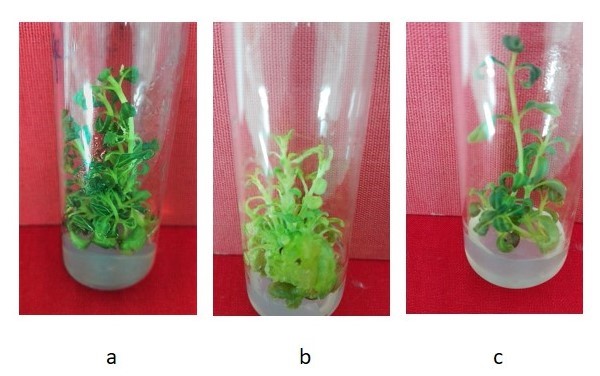
Micro propagation of H. officinalis L. on MS medium supplemented with a) 1.0 mg/L BAP and 0.1 mg/L IBA; b) 1.0 mg/L TDZ and 0.1 mg/L IBA; c) 1.0 mg/L Zeatin and 0.1 mg/L IBA.
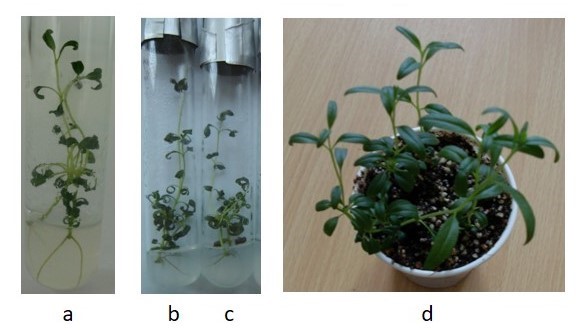
Rooted plants of H. officinalis L. on ½ MS medium supplemented with a) 0.1 mg/L IBA, b) 0.1 mg/L NAA c) 0.1 mg/L IAA, d) Ex vitro adapted plant.
The biologically active compounds including essential oils present in Hyssopus officinalis cultivated from seeds, in vitro propagated, and collected from natural habitats (region of Buchin Prohod – Godech Municipality (West Bulgaria, GPS data: 42°58ʹ6.67ʺN/ 23° 8ʹ51.75ʺE, 780 m a.s.l.) were compared. The content of the investigated nonenzymatic low molecular metabolites with antioxidant capacity, phenols and flavonoids were the highest in flowers and leaves in in vitro propagated plants. Leaf and flower extracts of H. officinalis in all three plant groups differed in their antioxidant potential, but the highest values were observed in those that were in vitro propagated. The highest concentration of essential oil was noted in plants from natural habitats. The essential oil yield from in vitro propagated plants was about 2 times higher than those derived from seed-propagated plants.
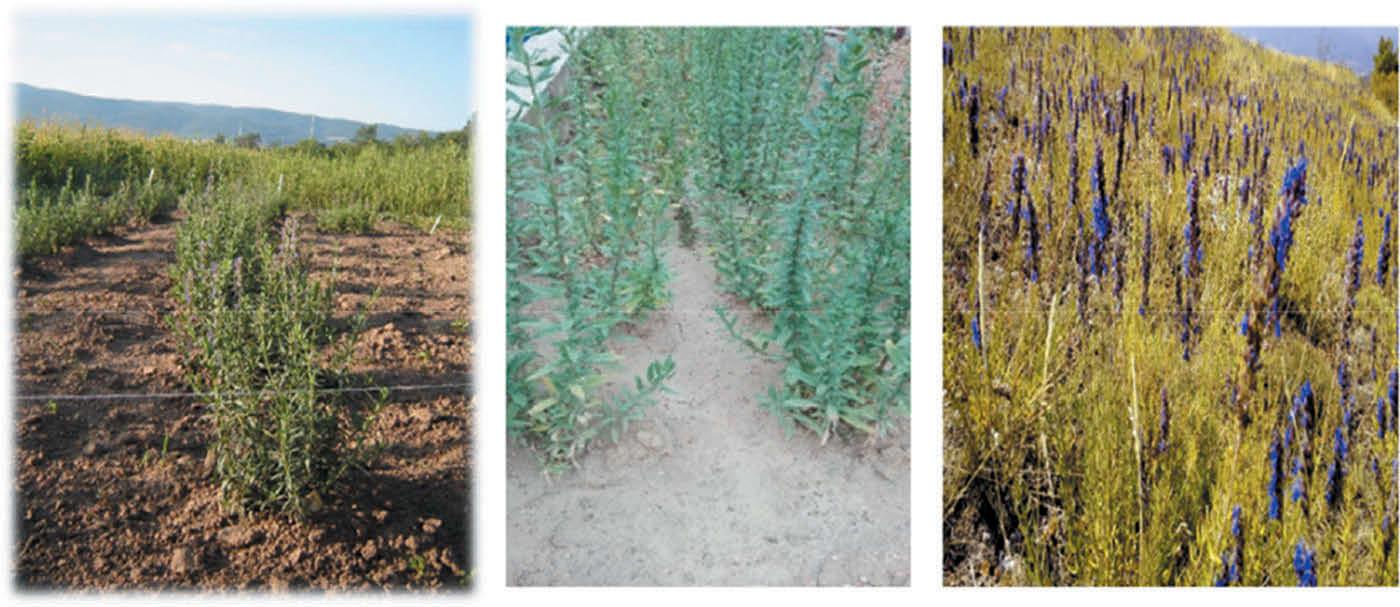
Hyssopus officinalis in vitro propagated (a), seed propagated (b) and from natural habitats (c).
Origanum heracleoticum L.
A study was conducted highlighting the development and performance achieved for the micropropagation of the Greek oregano (Origanum heracleoticum L.) using stem tip explants. The shoots were cultured on Murashige and Skoog (MS) medium supplemented with different concentrations of plant growth regulators – BAP, TDZ and zeatin at various concentrations (0.5 or 1.0 mg L-1). The induction of multiple shoots from stem tip segments was the highest in MS medium with added 1.0 mg L-1 zeatin. It was the most effective medium for shoot formation, which produced average number of shoots 3.8 with average shoot height of 3.9 cm. These shoots were transferred on half-strength MS medium containing three different auxins: IBA, NAA and IAA (0.1 and 0.5 mg L-1) for rooting, The multiple shoots were the most efficiently rooted on ½ MS medium supplemented with 0.5 mg L-1 IBA. Rooted plants showed the best adaptation on pots containing peat: perlite (2: 1 v/v). The higher rates of shoots number and height per plant have a positive relationship with the production of metabolites with antioxidant potential as phenols and flavonoids as well as with ferric reducing antioxidant potential.
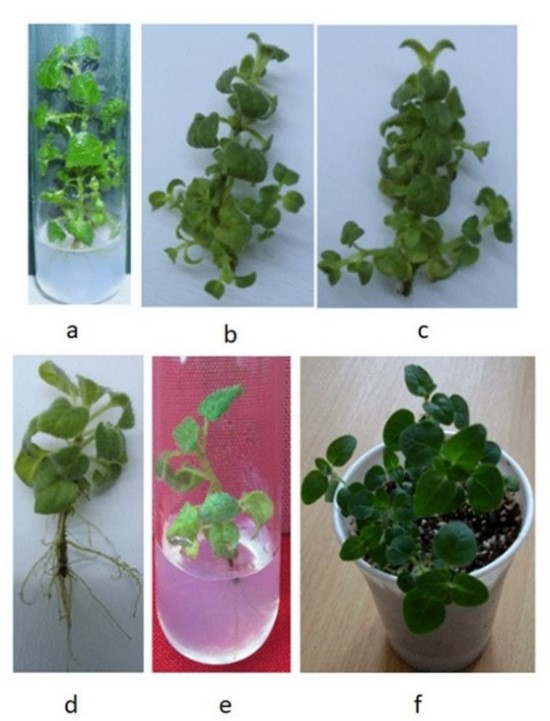
Micropropagation of O. heracleoticum: a) In vitro shoots with 500 mg L-1 CaCl2; b) in vitro propagated shoots with 1.0 mg L-1 zeatin after three weeks of culture; c) in vitro propagated shoots with 1.0 mg L-1 BAP after three weeks of culture; d) rooted plants with 0.5 mg L-1 IBA after 4 weeks of culture; e) rooted plants with 0.5 mg L-1 NAA after 4 weeks of culture, f) ex vitro adapted plants after eight weeks of culture.
The chemical composition of the essential oils of the aerial part and the antioxidant properties of Origanum heracleoticum L. leaves and flowers collected from different natural populations in Bulgaria (Kresna Gorge and Rhodopes Mountain) during the flowering stage were compared with in vitro propagated and field adapted plants.
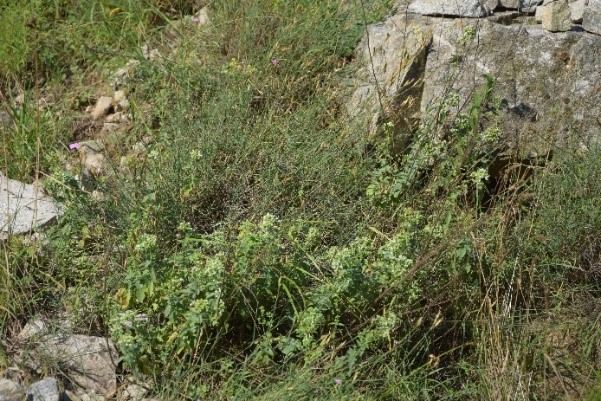 Explants for micro propagation from wild-growing plants from Gorna Breznitsa (Kresna Gorge) was used. The enzyme antioxidant potential characterized by the activity of superoxide dismutase, catalase, guaiacol peroxidase, ascorbate peroxidase as well as non enzyme antioxidant potential characterized by a content of total phenols, flavonoids, water- and lipid-soluble antioxidant metabolites was the highest in the flowers and leaves of the in vitro propagated and field adapted plants.
Explants for micro propagation from wild-growing plants from Gorna Breznitsa (Kresna Gorge) was used. The enzyme antioxidant potential characterized by the activity of superoxide dismutase, catalase, guaiacol peroxidase, ascorbate peroxidase as well as non enzyme antioxidant potential characterized by a content of total phenols, flavonoids, water- and lipid-soluble antioxidant metabolites was the highest in the flowers and leaves of the in vitro propagated and field adapted plants.
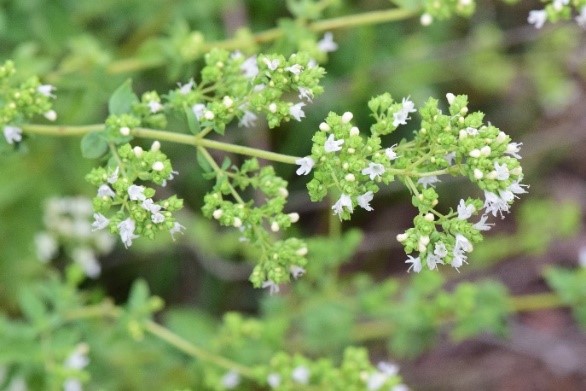
The value of this antioxidant activity was very similar to the values of the plants, collected from the Rafting centre and Gorna Breznitsa situated in the Kresna Gorge. Forty-five compounds in the O. heracleoticum L. essential oil collected from native populations were identified. Based on the essential oil composition in particular carvacrol and thymol content, the O. heracleoticum L. plants from all investigated natural populations from Bulgaria belonged to the carvacrol chemotype. Total monoterpenes content was not changed because of the micropropagation of Greek oregano, only the sesquiterpenes values increased.
Coleus forskohlii Briq
A simple protocol for in vitro rooting induction of the important medicinal plant Coleus forskohlii Briq with a high content of secondary metabolites with antioxidant activity was studied. For the in vitro germination seeds of C. forskohlii were placed on an MS medium including vitamines supplemented with 0.4 mg L-1 gibberellic acid. The obtained shoots were cultured on ½ MS medium contained IBA or IAA at concentrations of 0.1 and 0.5 mg L-1. The maximum plant rooting (95%) with mean values of 9.2 roots per explant, root length (5.1 cm) and root fresh weight (0.085 g) was obtained on ½ MS medium with 0.1 mg L-1 IAA after three weeks of culture. The plants were successfully ex vitro adapted with 93.3% survival on the mixture substrate of soil, peat and sand (2:1:1 v/v/v). The antioxidant enzymes activities (SOD, CAT, APX and GPO) showed the highest values when IBA was used for C. forskohlii micropropagation. Auxins used for C. forskohlii micropropagation influenced the level of secondary metabolites synthesis. ½ MS culture medium supplemented with 0.5 mg L-1 IAA cause the highest total phenol and flavonoid content as well as the highest total antioxidant activity (free radical scavenging capacity and ferric reducing antioxidant power). The results indicate that the organogenesis is a very complicated biological process involving up and downregulation of plant enzyme and non enzyme antioxidant protection system, which play an important role during the organogenesis of plants.
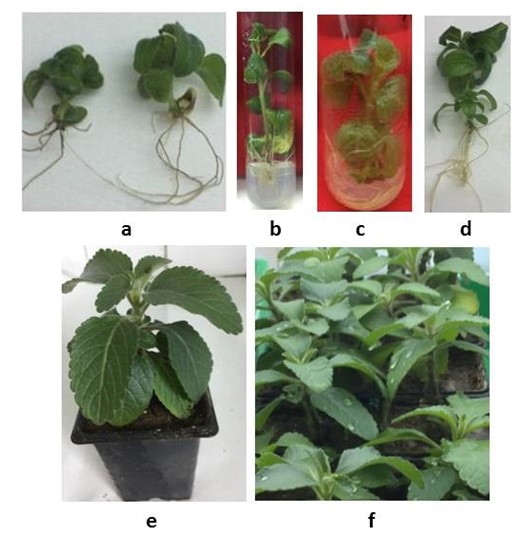
Micropropagation of Coleus forscohlii: a) seedling initiation on MS medium with 0.4 mg L-1 GA3 and 1.0 mg L-1 CaCl2; b) rooting on ½ MS medium supplemented with 0.1 mg L-1 IBA; c) and d) rooting on ½ MS medium supplemented with 0.1 mg L-1 IAA; e) and f) in ex vitro adapted plants.
Physalis peruviana L.
The seed explants of Physalis peruviana L. was used as the segments cultured on MS medium supplemented with different concentrations of plant growth regulators BAP, zeatin and TDZ. The maximum number of shoots per explant (6.6) and shoot length (1.5 cm) were recorded at MS medium with 1.0 mg/L TDZ after five weeks of culture. The micro-shoots produced normal roots within two weeks of culture on the half-strength MS medium with the two auxin supplements: IBA or IAA at concentrations 0.1 mg/L and 0.5 mg/L. The best plant rooting was achieved on ½ MS medium with 0.1 mg/L IBA (number of shoots per explant 12.1 with a shoot height 5.2 cm) and 0.1 mg/L IAA (number of shoots per explant 10.4 with a shoot height 7.3 cm) after four weeks of culture. The micropropagation protocol was characterized by a rapid proliferation of shoots and easy rooting of the microshoots. The multiple plants were successfully ex vitro adapted with 95% survival after two months of ex vitro conditions.
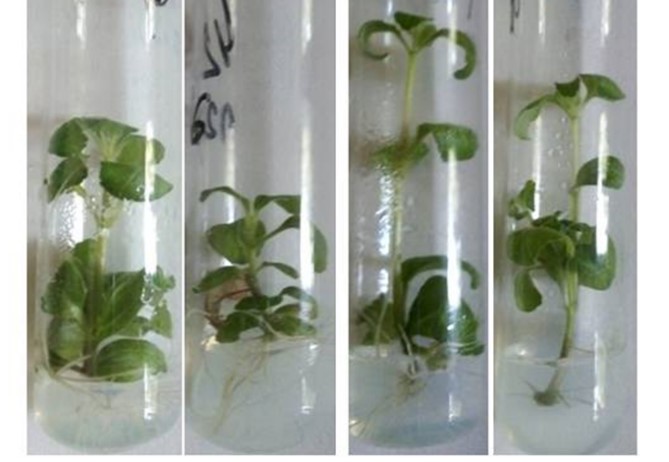
In vitro rooting of Ph. peruviana: a) ½ MS medium with 0.1 mg/l IBA; b) ½ MS medium with 0.5 mg/L IBA; c) ½ MS medium with 0.1 mg/L IAA; d) ½ MS medium with 0.5 mg/L IAA after four weeks of culture.
The oxidative stress induced by plant micropropagation activates enzymes and non-enzymatic components of the antioxidative defence system in Ph. peruviana L. The highest activities of SOD, CAT, APX and GRO were found in variants with the lower concentration of BAP, Zeatin and TDZ.
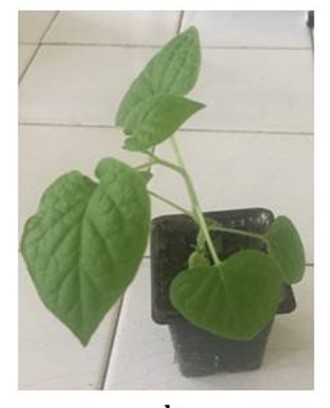 Differences were recorded regarding the content of secondary metabolites provoked by the used growth regulators in the two studied concentrations. The higher cytokinin concentrations increased total antioxidant power measured by free radical-scavenging activity (DPPH method) and ferric reducing antioxidant potential (FRAP method) in Ph. peruviana L. plantlets.
Differences were recorded regarding the content of secondary metabolites provoked by the used growth regulators in the two studied concentrations. The higher cytokinin concentrations increased total antioxidant power measured by free radical-scavenging activity (DPPH method) and ferric reducing antioxidant potential (FRAP method) in Ph. peruviana L. plantlets.
